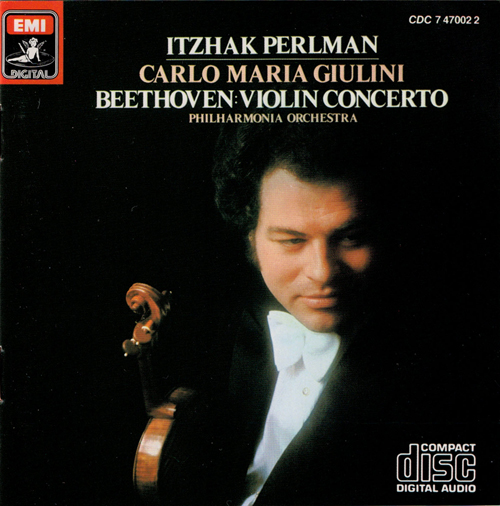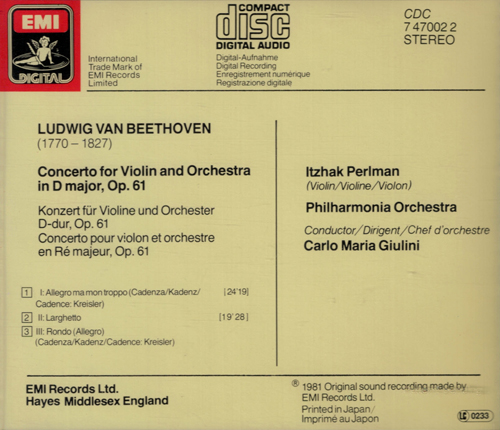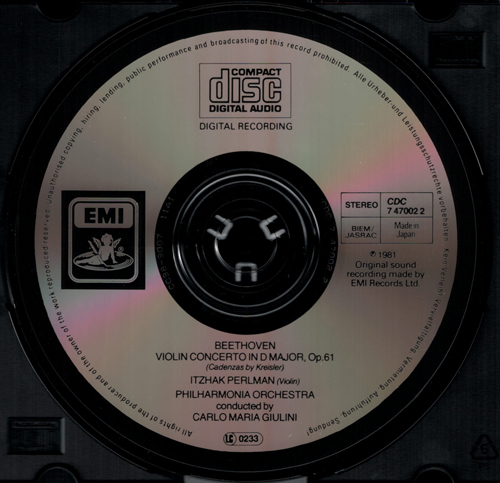Early Japan-for-U.S./Europe EMI Classical CDs
http://waterloomilitaria.com/wp-cron.php?doing_wp_cron=1589406685.7795269489288330078125 February 14th, 2016
go site A number of posts here have discussed original CD label designs that were replaced early on by some other designs. In many instances, the original design is viewed as more aesthetic and desirable by collectors. A significant contributor to collector demand is the rarity often associated with the early design. An extreme example is the class of colorful target designs used by WEA that was replaced in the mid-’80s by workaday black text with no paint coating. Target CDs are collectable and sometimes valuable. The later plain pressings, not so much. Here we consider an example of the original design being less aesthetic but still collectable.
follow link EMI started releasing CDs from different genres in 1982, with their releases becoming more widespread in the U.S. and Europe in 1983. The catalog numbers for their early U.S. and European pop, rock, and jazz titles follow the form CDP 7 46XXX 2. The ‘P’ presumably stands for popular. For classical titles, EMI used catalog numbers of the type CDC 7 47XXX 2. In this post, we will discuss these early classical titles.
Buying Tramadol In Australia The earliest EMI classical CDs released in the U.S. and Europe were pressed in Japan. Starting in the mid-’80s, some titles were also pressed in West Germany, Switzerland, the U.K., France, and the U.S. Let’s focus on the Japanese pressings, which were produced by the Toshiba-EMI plant. The earliest Japanese pressings for EMI have a thick black ring along the perimeter, a black EMI logo, black text, and no paint coating. Some of these early pressings show the original Toshiba-EMI “thick” matrix code font. Others show a later “thin” Toshiba-EMI font. These earliest EMI classical titles also have no barcode on the back insert.
follow site By the mid-’80s, EMI changed the label design by adding some color. These later EMI issues, many of which were still pressed in Japan, have a thick red ring along the perimeter, red and black EMI logo, black text, and no paint coating. So EMI transitioned to color, and this label design is very common.
Tramadol Ohne Rezept Online An example of the early all-black EMI label design is brilliant violinist Itzhak Perlman playing Beethoven violin concertos. Perlman is accompanied by the Philharmonia Orchestra, conducted by Carlo Maria Giulini. This recording was released under catalog number CDC 7 47002 2. The disc has the black ring and black EMI logo, and it can be found with the early thick or later thin Toshiba-EMI matrix code font. The inserts are identical for the two pressings. The thick-font pressing has matrix code “CC38-3007-6 1A2” and “CDC 7 47002 2”, while the thin-font pressing has matrix code “CC38-3007 11A1” and “CDC 7 47002 2”. Both pressings have two groups of matrix code characters that are separated around the plastic ring by 180 degrees. CC38-3007 is the catalog number for the original Japanese CD release of this title. Many of the early Japan-for-U.S./Europe EMI pressings have the Japanese catalog number in the matrix code.
here Shown below is the cover artwork and back insert for the early Japan-for-U.S./Europe Beethoven violin concertos pressings, as well as one of the original Japanese pressings.
http://waterloomilitaria.com/?id_product=470
http://waterloomilitaria.com/?id_product=569 
http://waterloomilitaria.com/wp-cron.php?doing_wp_cron=1589403436.8792450428009033203125 The cover for Ludwig van Beethoven (Itzhak Perlman, Violin; Philharmonia Orchestra; Carlo Maria Giulini, Conductor) Concerto for Violin and Orchestra in D major, Op. 61 (Japan, EMI, catalog number CDC 7 47002 2). The catalog number is printed in the top right corner.
http://waterloomilitaria.com/product/crimean-war-officers-field-cap/?add-to-cart=6034

The back insert for Ludwig van Beethoven (Itzhak Perlman, Violin; Philharmonia Orchestra; Carlo Maria Giulini, Conductor) Concerto for Violin and Orchestra in D major, Op. 61 (Japan, EMI, catalog number CDC 7 47002 2). There is no barcode. As noted in the bottom right corner, this insert was printed in Japan.

An early Japanese pressing of Ludwig van Beethoven (Itzhak Perlman, Violin; Philharmonia Orchestra; Carlo Maria Giulini, Conductor) Concerto for Violin and Orchestra in D major, Op. 61 (Japan, EMI, catalog number CDC 7 47002 2). The disc was pressed by Toshiba-EMI. This particular disc shows the second thin Toshiba-EMI matrix code font. The matrix code is “CC38-3007 11A1” and “CDC 7 47002 2”.